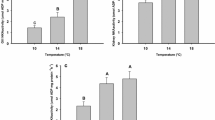Abstract.
Effects of temperature on activities of key metabolic enzymes, citrate synthase (CS), NADP-dependent isocitrate dehydrogenase (NADP-IDH), aspartate aminotransferase (AAT), pyruvate kinase (PK) and phosphoenolpyruvate carboxykinase (PEPCK), were studied in high and low shore Littorina saxatilis and in low shore L. obtusata from the temperate North Sea and the sub-arctic White Sea. It was found that adaptation of L. saxatilis and L. obtusata to life at different latitudes and/or shore levels involves constitutive changes in enzymatic activities, so that animals naturally adapted to (micro-) environments with lower mean temperatures (i.e. in the White Sea or at low shore levels) tend to have higher enzyme activities as compared to their counterparts from warmer habitats (e.g. the North Sea or high shore levels, respectively). This suggests metabolic temperature compensation in different populations/subpopulational groups of this eurythermal species. Activities of all five studied enzymes were modulated by adaptations to high shore life in L. saxatilis, whereas only NADP-IDH, PK and PEPCK had different activities in animals from different latitudes. Adaptation to high shore life also involved an enhanced potential for anaerobic energy production via the succinate pathway in Littorina spp. (measured as the ratio of PEPCK and PK activities), which increased in the order: low shore L. obtusata≤ low shore L. saxatilis< high shore L. saxatilis. Possibly, an increased anaerobic capacity is advantageous for snails at high shore levels, where they may experience limited oxygen access during prolonged air exposure. In contrast, the activation energies of the respective enzymes did not reveal a consistent pattern of variation and were similar in animals from different latitudes and shore levels. Arrhenius breakpoint temperatures (ABT) of the studied enzymes characterising a change in the thermal properties of the protein were found well within the average highs of ambient temperatures (20–35°C). Denaturation temperatures (T d), indicating heat inactivation of the protein, were close to the environmental extremes experienced by L. saxatilis during summer low tide. These findings suggest that the metabolic machinery of this eurythermal species may function close to its physiological limits during summer low tide, especially at high shore levels.
Similar content being viewed by others
Author information
Authors and Affiliations
Additional information
Electronic Publication
Rights and permissions
About this article
Cite this article
Sokolova, .I., Pörtner, .H. Temperature effects on key metabolic enzymes in Littorina saxatilis and L. obtusata from different latitudes and shore levels. Marine Biology 139, 113–126 (2001). https://doi.org/10.1007/s002270100557
Received:
Accepted:
Issue Date:
DOI: https://doi.org/10.1007/s002270100557




